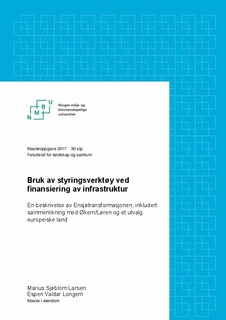| dc.contributor.advisor | Kalbro, Thomas | |
| dc.contributor.author | Longem, Espen Valdar | |
| dc.contributor.author | Larsen, Marius Sjøblom | |
| dc.coverage.spatial | Norway, Oslo | nb_NO |
| dc.date.accessioned | 2017-08-31T10:25:49Z | |
| dc.date.available | 2017-08-31T10:25:49Z | |
| dc.date.issued | 2017 | |
| dc.identifier.uri | http://hdl.handle.net/11250/2452545 | |
| dc.description.abstract | Denne oppgaven omhandler bruk av styringsverktøy ved finansiering av infrastruktur, med utgangspunkt i transformasjonsområdet Ensjø i Oslo kommune. Vi tar for oss ulike styringsverktøy som ble benyttet for å kartlegge infrastrukturutviklingsbehovet, og fordeling av kostnadene knyttet til dette. Oppgaven tar utgangspunkt i offentlig tilgjengelige dokumenter, supplert med intervjuer for å få ulike perspektiver på funnene.
Infrastrukturtiltakene er belyst gjennom veiledende prinsipplan for det offentlige rom, hvor de enkelte tiltakene er beskrevet. Dette ble gjort tidlig i transformasjonsprosessen, hvilket har medført forutsigbarhet for utbyggere og kommunen ved fremforhandling av utbyggingsavtalene. Kostnadsfordelingen ble pålagt de ulike utbyggerne gjennom utbyggingsavtalene. Anleggsbidragene varierer i størrelse og type, men totalt sett er fordelingen forholdsmessig til utbyggers tiltak og nytte. Gjennomsnittlig anleggsbidrag er på ca. kr 1 100 per m2, med et variasjonsspenn på ca. kr 550 per m2. Dette spennet skyldes både konkrete vurderinger om utbyggingsområdets lokasjon i transformasjonsområdet, samt at det er ulik fordeling mellom kontantbidrag og realytelser i de ulike avtalene.
Det er gjort en sammenlikning mellom finansiering av infrastruktur på Ensjø og Løren/Økern, som er et liknende transformasjonsområde. Det gjennomsnittlige anleggsbidraget er høyere på Løren/Økern enn på Ensjø, hvilket skyldes at den overordnede planleggingen ikke fant sted før 15 år etter at utbyggingen ble igangsatt på Løren/Økern. På Ensjø ble planleggingen gjort på et tidligere stadium, noe som har medført forutsigbarhet og forholdsmessighet for utbyggerne. Utover dette er det også gjort en internasjonal sammenlikning av prosessen rundt finansiering av infrastruktur. Her ble det gjort funn som belyser at det er mange likhetstrekk i prosessen rundt finansiering av infrastruktur i Norge og et utvalg andre europeiske land.
Med dette som grunnlag kan vi med stor sannsynlighet si at finansieringen av infrastruktur på Ensjø var en transparent prosess, med forutsigbarhet og forholdsmessighet for de involverte partene. | nb_NO |
| dc.description.abstract | This master thesis adresses the financing of infrastructure in the Ensjø transformation area of Oslo municipality. The assignment includes the various management tools used to map the need for developing infrastructure and the associated distribution of costs. The findings in this assignment are based on publicly available documents, supplemented with interviews to gain different perspectives on the findings.
Infrastructure measures are highlighted through the guiding principles for the public space, where the measures are described. This was carried out early in the transformation process, which has resulted in predictability for developers and the municipality in negotiating the development agreements. The cost allocation was imposed on the various developers through negotiated development agreements. The construction contributions vary in size and type, but overall, the distribution is proportional to the developer's measures and benefits. The average construction contribution is approximately NOK 1 100 per m2, with a variation span of approximately NOK 550 per m2. This gap is caused by both concrete assessments of the development areas location, and is also due to different distribution between cash and construction contributions in the various development agreements.
A comparison of how financing of infrastructure measures has been conducted at Ensjø and at Løren/Økern has been made. The average facility contribution is higher on Løren/Økern than on Ensjø, which is because the general planning did not take place until 15 years after the development was initiated. At Ensjø, the planning was initiated at an earlier stage, which has led to predictability and proportionality for the developers. In addition to this, an international comparison of the process of financing infrastructure has also been described. These findings indicate that there are many similarities in the process of financing infrastructure in Norway and the selection of other European countries.
On this basis, we can assume that the financing of infrastructure at Ensjø was a transparent process, with predictability and proportionality for the involved parties. | nb_NO |
| dc.language.iso | nob | nb_NO |
| dc.publisher | Norwegian University of Life Sciences, Ås | nb_NO |
| dc.rights | Attribution-NonCommercial-NoDerivatives 4.0 Internasjonal | * |
| dc.rights.uri | http://creativecommons.org/licenses/by-nc-nd/4.0/deed.no | * |
| dc.subject | Ensjø | nb_NO |
| dc.subject | Utbyggingsavtaler | nb_NO |
| dc.subject | VPOR | nb_NO |
| dc.subject | Anleggsbidrag | nb_NO |
| dc.title | Bruk av styringsverktøy ved finansiering av infrastruktur : en beskrivelse av Ensjøtransformasjonen, inkludert sammenlikning med Økern/Løren og et utvalg europeiske land | nb_NO |
| dc.type | Master thesis | nb_NO |
| dc.subject.nsi | Bebyggelses‑ og reguleringsplanlegging: 234 | nb_NO |
| dc.source.pagenumber | 115 | nb_NO |
| dc.description.localcode | M-EIE | nb_NO |

